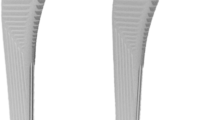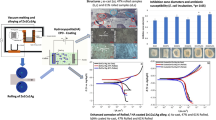Summary
Using bone cement type Palacos to bond a femurhead-endoprosthesis into the femur a considerable amount of heat is found radiated from the polymerising bone cement into the medullary canal of the femur. Partly this heat is absorbed by the stem of the prosthesis. In tests using iron-constantan thermocouples the setting temperature of Palacos was measured in fresh femurs at 37°C at the plane of contact between bone and Palacos, at the metal stem of the prosthesis inside the cement, at the head of the prosthesis, and on the outer side of the femoral cortex. At the plane of contact between bone and cement the temperature rose above coagulation temperature of proteins under unfavourable conditions (e.g. a thick layer of Palacos). Using the curette with discretion in preparing the femoral shaft for the acceptance of the prosthesis will result in a thinner layer of Palacos thus reducing the peaks of polymerisation temperatures.
Résumé
Quand on fixe au fémur des endoprothèses, il se libère une chaleur de polymérisation considérable dans le canal médullaire du fémur en raison de la réaction exothermique du ciment Palacos. Cette chaleur est partiellement absorbée par la tige de l'endoprothèse. A l'aide des couples thermo-electriques (fer et constantan) on a mesuré au cours d'expériences pratiquées sur des fémurs frais, chauffés à 37°C, les variation de température à la zone de contact os — Palacos, à la tige de prothèse, à la tête de la prothèse et à la paroi extérieure de l'os. Les températures maximales mesurées à la zone de contact os — Palacos dépassent dans des conditions défavorables (épaisse couche de Palacos) la température de coagulation des protéines. En pratiquant seulement un léger curetage de l'assise de la prothèse, il est possible d'obtenir une couche de Palacos plus mince ayant une température maximale plus basse.
Zusammenfassung
Beim Einzementieren von Endoprothesen im Oberschenkelschaft wird im Oberschenkelmarkraum infolge der exothermen Reaktion des auspolymerisierenden Knochenzementes Palacos erhebliche Polymerisationswärme frei. Diese Polymerisationswärme wird zum Teil vom Schaft der Endoprothese aufgenommen. Mit Hilfe von Eisen-Konstantan-Thermoelementen wurde experimentell in frischen, auf 37°C erwärmten Oberschenkelknochen der Temperaturverlauf an der Palacos-Knochen-Grenze, am Prothesenschaft, am Prothesenkopf und an der Knochenaußenwand gemessen. Die gemessenen Maximaltemperaturen liegen bei ungünstigen Verhältnissen (dicke Palacos-Schicht) an der Palacos-Knochen-Grenze über der Koagulationstemperatur von Eiweiß. Durch sparsames Auscurettieren des Prothesenschaftbettes kann ein dünneres Palacos-Bett mit niedrigerer Maximaltemperatur erzielt werden.
Similar content being viewed by others
Literatur
Carstensen, G.: Eine neue Methode der Gefäßkonservierung durch Einbettung in einen schnellhärtenden Kunststoff. Chirurg 31, 49 (1960).
Charnley, J.: Anchorage of the femoral head prosthesis to the shaft of the femur. J. Bone Jt Surg. 42-B, 28 (1960).
—— The Bonding of prothesis to bone by cement. J. Bone Jt Surg. 46-B, 516 (1964).
Heidsieck, C., R. Bässler u. J. Kohn: Experimentelle Untersuchungen zur Frage der Knochenkonservierung in Kunststoff. Dtsch. zahnärztl. Z. 22, 518 (1967).
Herrmann, K. O.: Die Verwendung des selbsthärtenden Kunststoffes Palavit zur Substitutionsbehandlung bei Knochenerkrankungen und Knochenbrüchen. Ärztl. Forsch. 7, 543 (1953).
—— Operative Behandlungsmethoden beim menschlichen Knochenbruch mit Hilfe von Kunststoff. Erfahrungsheilkunde 3, 169 (1954).
Hoffmann, G.: Feingewebliche Untersuchungen zur Verträglichkeit von Palavit im Tierversuch. Verh. dtsch. orthop. Ges., 42. Kongreß. 86, 352 (1954).
Hoppe, W.: Tierexperimentelle Untersuchungen über Gewebsreaktionen auf Injektionen von autopolymerisierendem Kunststoff. Dtsch. zahnärztl. Z. 11, 837 (1956).
Hulliger, L.: Untersuchungen über die Wirkung von Kunstharzen (Palacos und Ostamer) in Gewebskulturen. Arch. orthop. Unfall-Chir. 54, 581 (1962).
Huggler, A. H.: Die Alloarthroplastik des Hüftgelenkes mit Femurschaft-und Totalendoprothesen. Stuttgart: Thieme 1968.
Idelberger, M. K.: Arthroplasties de hanche avec prothése en acrylic. Rev. Chir. orthop. 42, 311 (1956).
Lehnartz, E.: Chem. Physiologie, S. 87. Berlin-Göttingen-Heidelberg: Springer 1959.
McKee, G. K.: Artificial hip joint. J. Bone Jt Surg. 33-B, 465 (1951).
——, and J. Watson-Farrar: Replacement of arthritic hips by the McKee-Farrar prosthesis. J. Bone Jt Surg. 48-B, 245 (1966).
Moore, A. T.: Metal hip joint. A new self-locking Vitallium prosthesis. Sth. med. J. (Bgham, Ala.) 45, 11 (1952).
—— The self-locking metal hip prosthesis. J. Bone Jt Surg. 39-A, 811 (1957).
Müller, M. E.: Die Verwendung von Kunstharzen in der Knochenchirurgie. Arch. orthop. Unfall-Chir. 54, 513 (1962).
Ohnsorge, J.: Festkörperoberflächenuntersuchungen mit Hilfe des Rasterelektronenmikroskops. (Im Druck.)
--, u. R. Holm: Änderungen der Spongiosafeinstruktur unter dem Einfluß des auspolymerisierenden Knochenzementes. (Im Druck.)
--, u. W. Steinbeck: Rasterelektronenmikroskopische Darstellung von Korrosionseffekten an scheinbar unbeschädigten Metallimplantaten. Vortrag 56. Kongr. Dtsch. Ges. Orthop. Traum. 19. 9. 1969 Wien, Verh.-Bd.
——, u. K. Kroesen: Thermoelektrische Temperaturmessungen des abhärtenden Knochenzementes „Palacos“. Z. Orthop. 106, 476–482 (1969).
Otto, E.: Fortschritte in der Behandlung von Schädeldefekten. Chirurg 36, 273 (1965).
Pfeiffer, R.: Fusion der Wirbelsäule mit dem Autopolymerisat „Palacos“. Arch. orthop. Unfall-Chir. 62, 250 (1967).
Postel, M., B. Teinturier et J. Dubousset: Techniques et premiers résultats de l'arthroplastie de la hanche avec la prothèse totale de McKee. Mém. Acad. Chir. 92, 870 (1966).
Ring, P. A.: Complete replacement. Arthroplasty of the hip by the Ring prosthesis. J. Bone Jt Surg. 50-B, 720 (1968).
Rosenmeyer, F. W.: Schnell herstellbare Kunststoffplastik zur Deckung von Schädelknochenlücken. Acta neurochir. (Wien) Suppl. III, 118 (1955).
Schenk, R.: s. Willenegger, H., R. Schenk u. W. Bandi.
Scheuba, G.: Osteosynthese pathologischer Frakturen. Zbl. Chir. 90, 1737 (1965).
Thomalske, G.: Die plastische Deckung von Schädelknochendefekten im Schnellverfahren nach Woringer. Med. Bilder-Dienst, Juni 1962, Heft 2, S. 3.
Thompson, F. R.: Two and a half years' experience with vitallium intramedullary hip prosthesis. J. Bone Jt Surg. 36-A, 3 (1954).
Unger, R. R., u. H. Sollmann: Die Versorgung von Schädelcalottendefekten mit Palacos. Zbl. Chir. 89, 849 (1964).
Wagner, A., u. W. Umbach: Die plastische Deckung von knöchernen Schädeldefekten. Dtsch. med. J. 14, 191 (1963).
Willenegger, H., R. Schenk u. W. Bandi: Die Anwendung von Leimsubstanzen in der Knochenchirurgie. Med. Mittlg. (Melsungen) H. 100, S. 2487 (1966).
Willert, H. G., u. A. Schreiber: Unterschiedliche Reaktionen von Knochen- und Weichteillager auf autopolymerisierende Kunststoffimplantate. Z. Orthop. 106, 231 (1969).
Author information
Authors and Affiliations
Rights and permissions
About this article
Cite this article
Ohnsorge, J., Goebel, G. Oberflächentemperaturen des abhärtenden Knochenzementes Palacos beim Verankern von Metallendoprothesen im Oberschenkelmarkraum. Arch orthop Unfall-Chir 67, 89–100 (1969). https://doi.org/10.1007/BF00416830
Received:
Issue Date:
DOI: https://doi.org/10.1007/BF00416830




